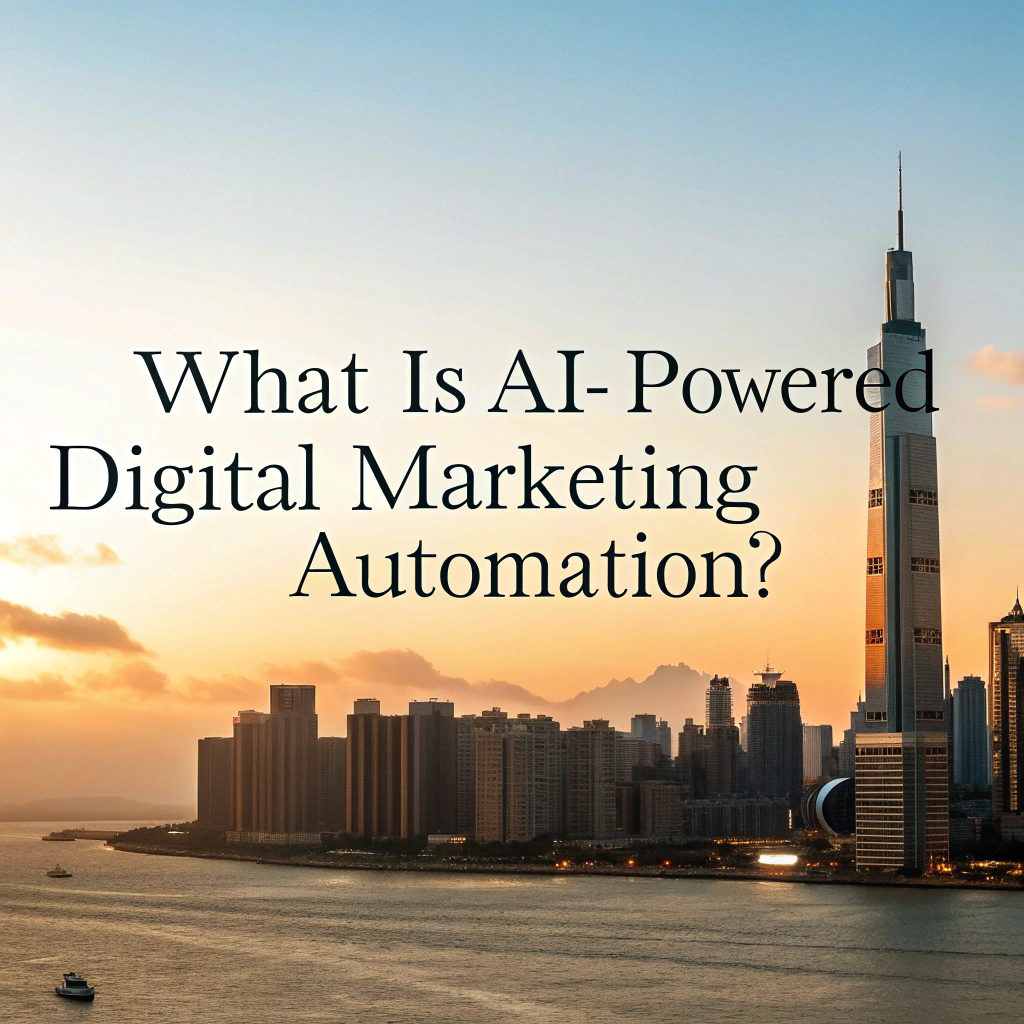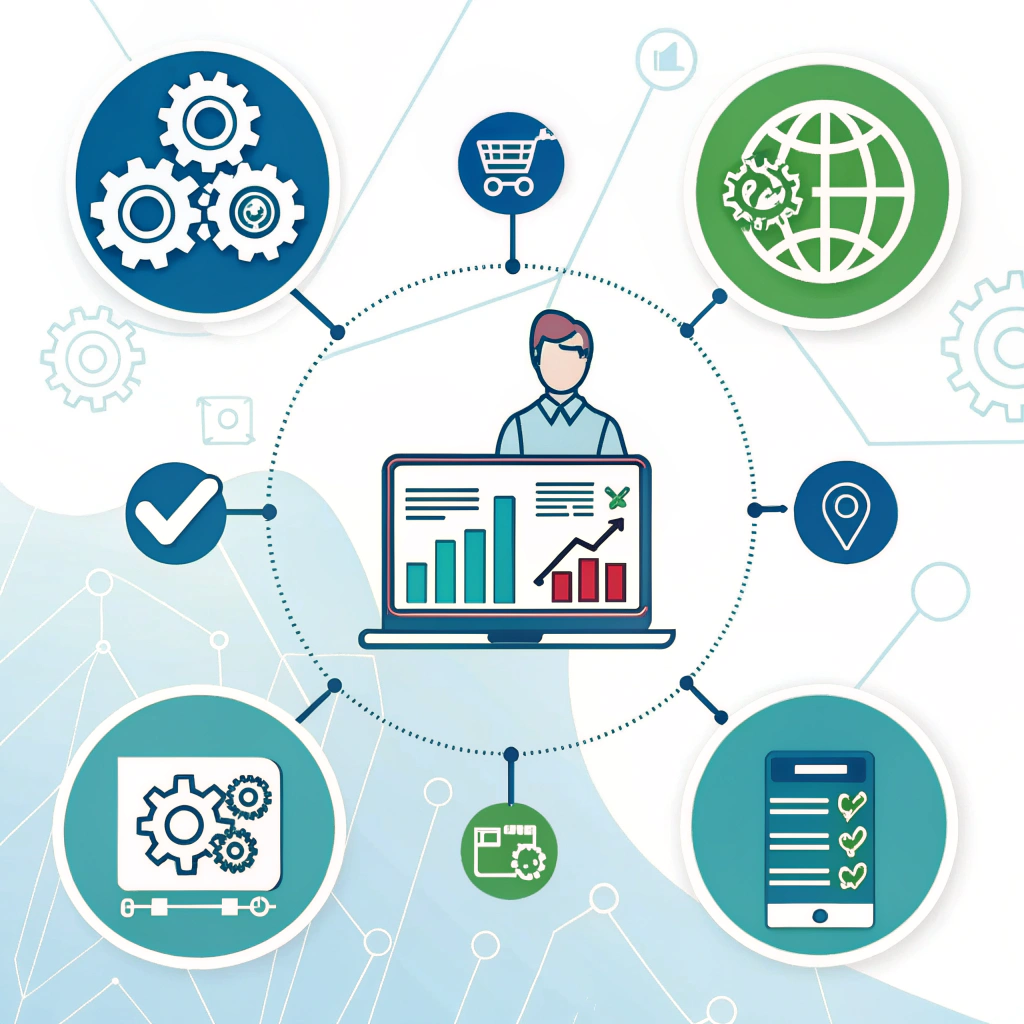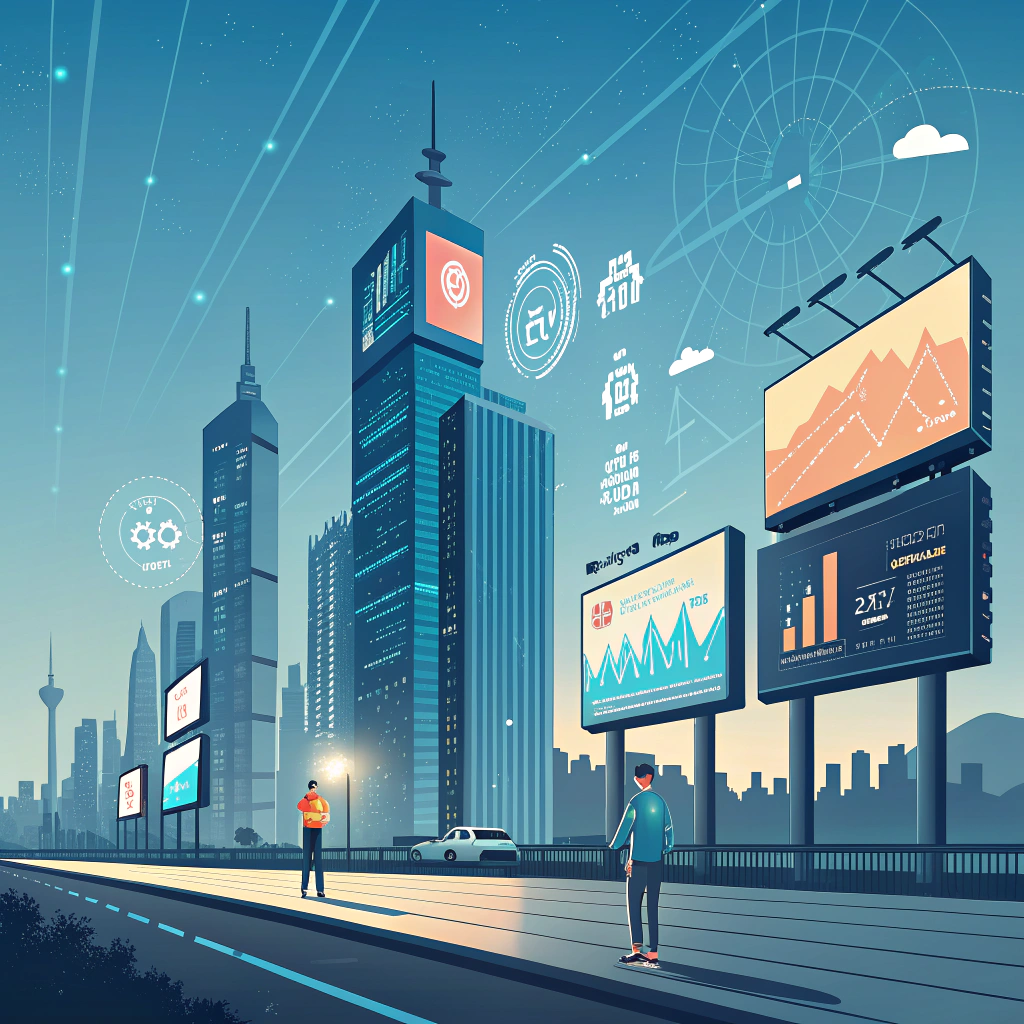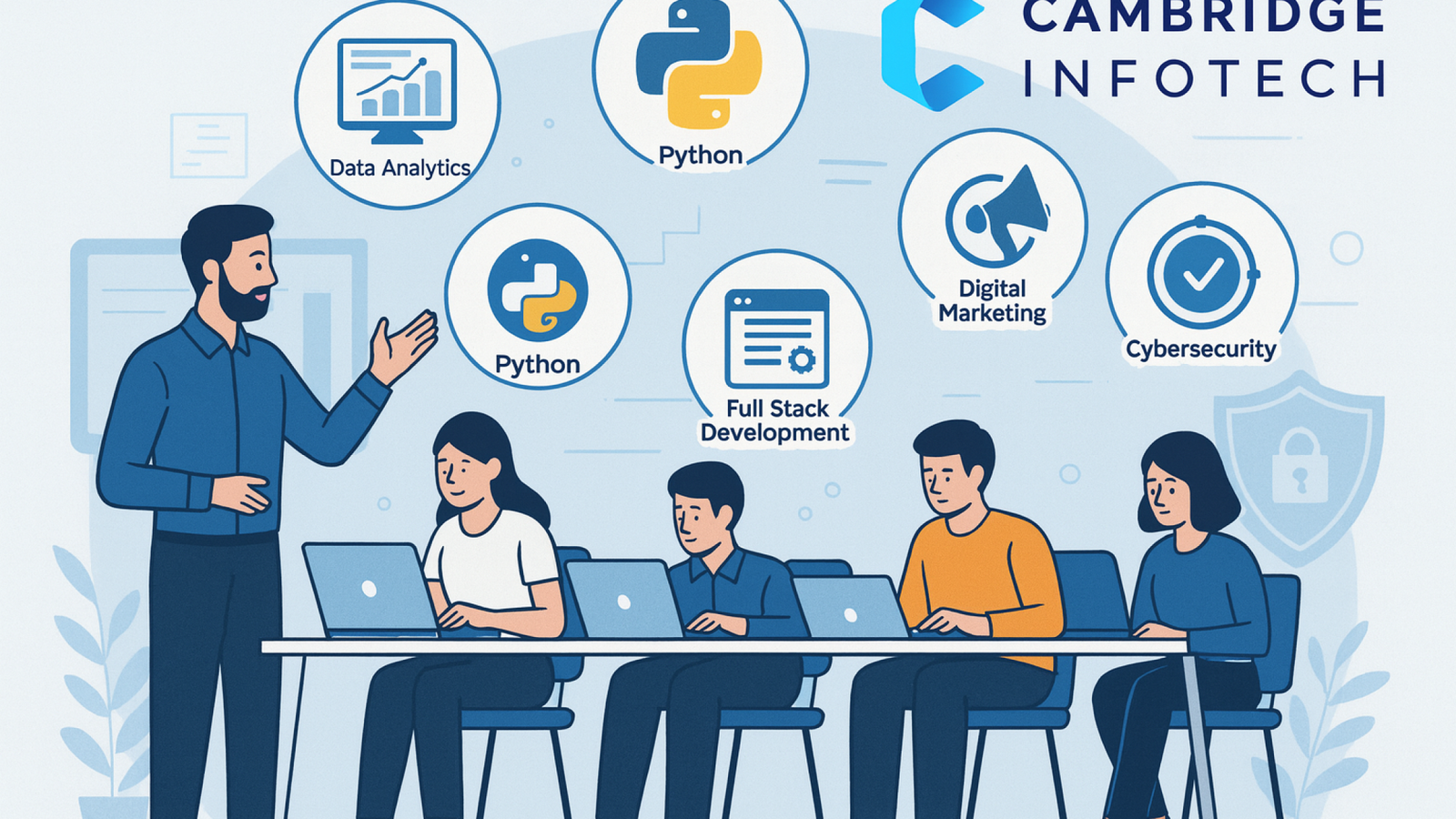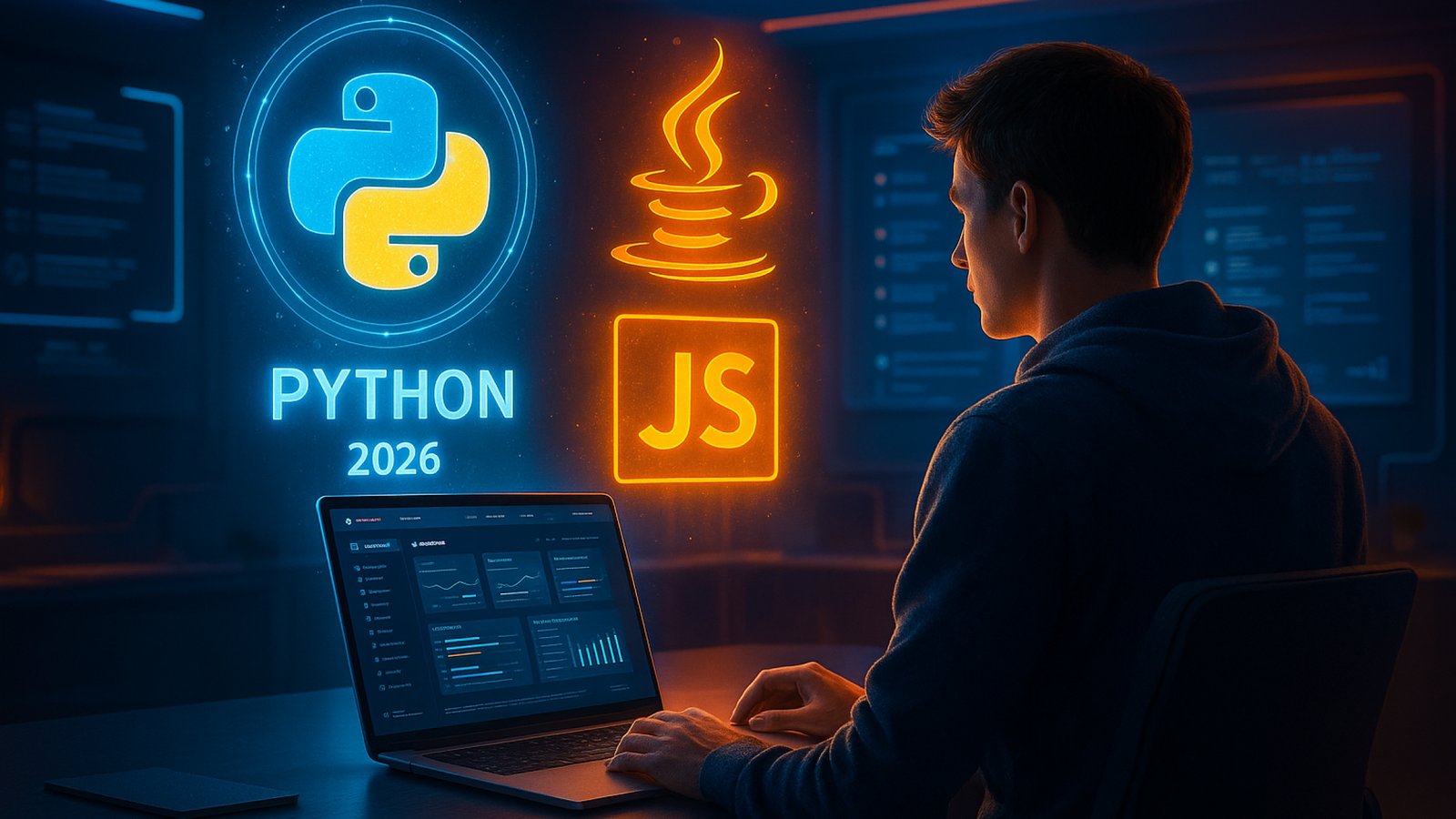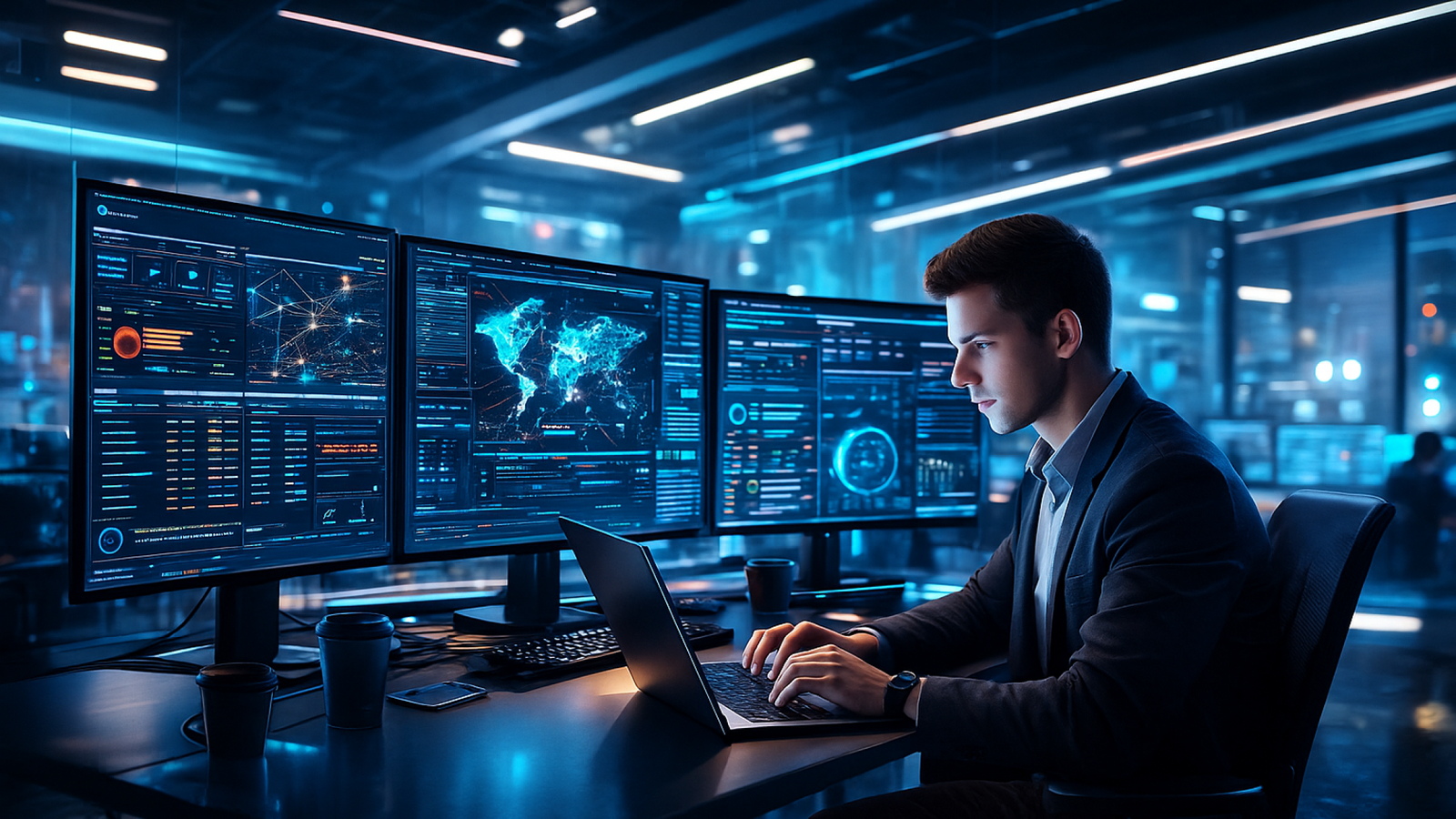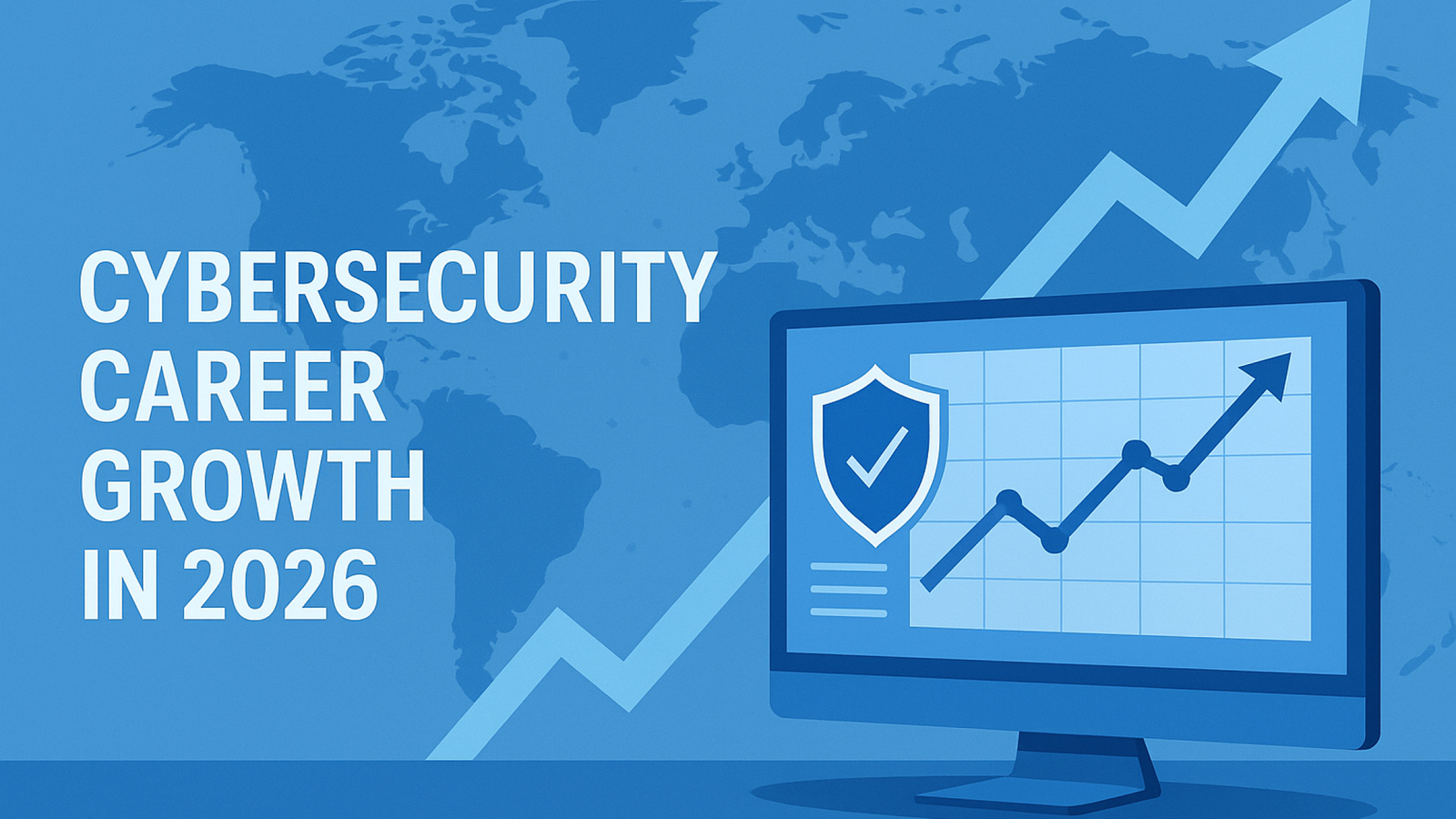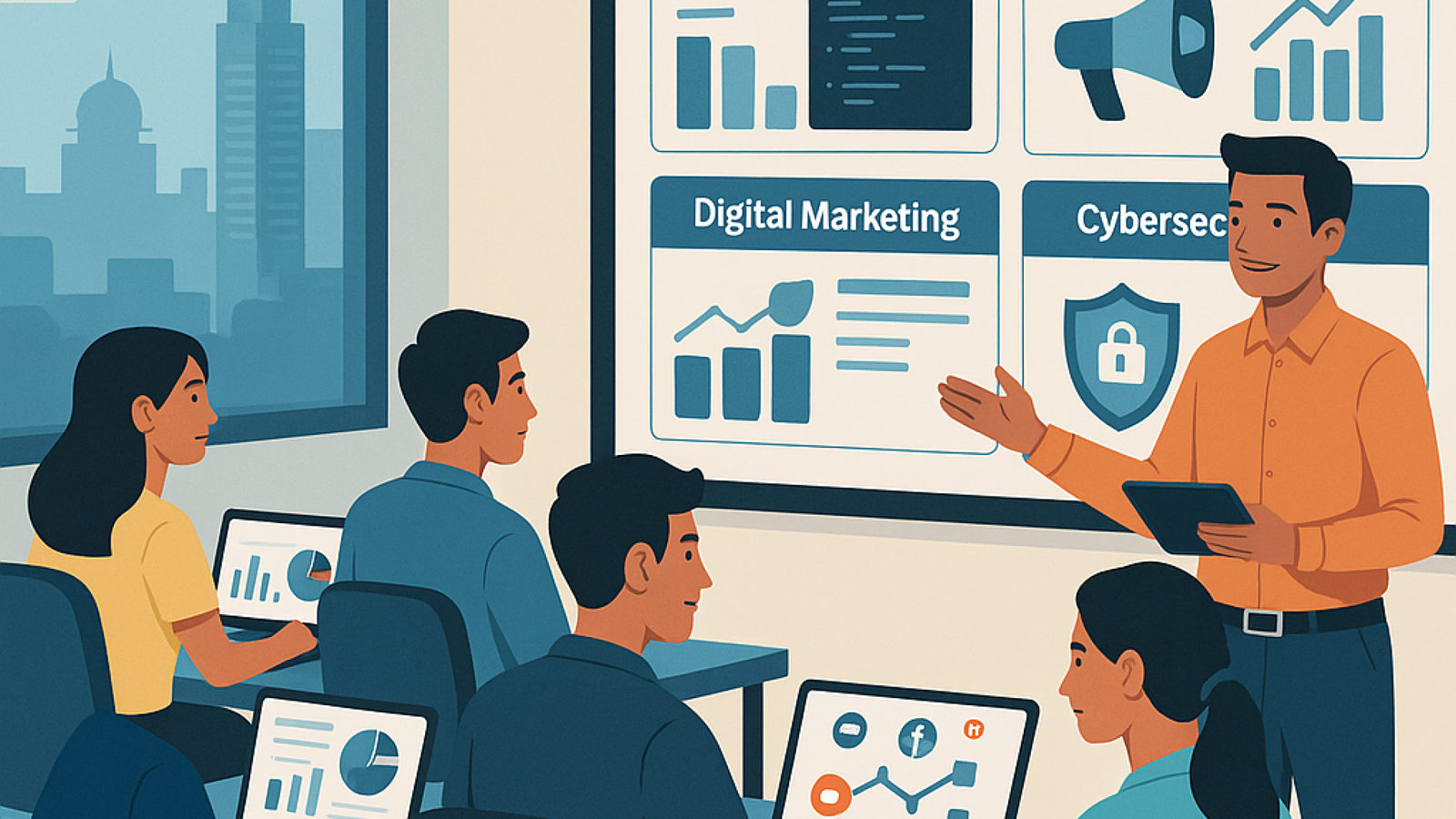The Ultimate Guide to AI-Powered Digital Marketing Automation (2026)
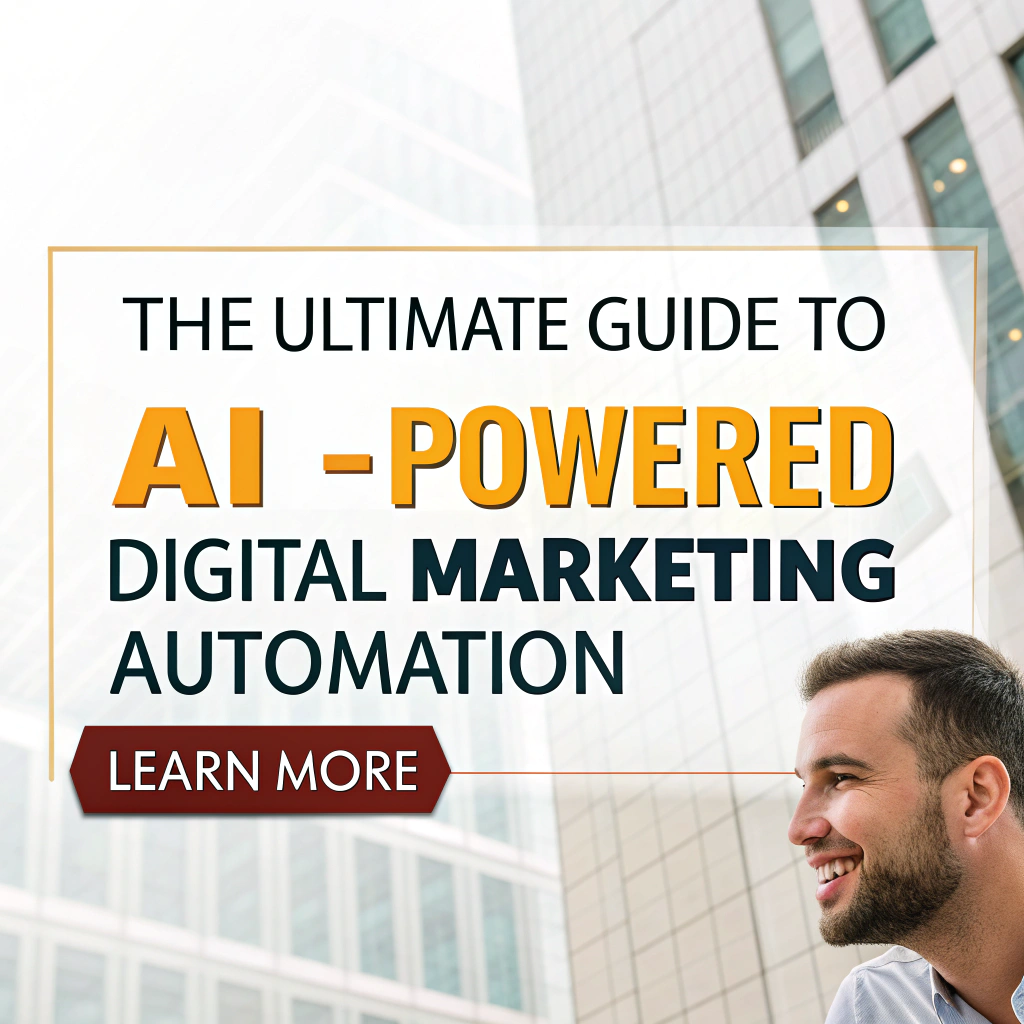
Introduction
Artificial Intelligence (AI) is no longer a futuristic concept—it’s here, and it’s transforming the digital marketing landscape. One of the most powerful applications today is AI-powered digital marketing automation. Imagine running campaigns that adapt in real-time, predict customer behavior, and deliver personalized experiences—all with minimal human intervention.
By 2026, AI automation isn’t just a nice-to-have—it will be essential for marketers, businesses, and professionals who want to stay ahead of the competition. Those who embrace AI automation will save time, reduce costs, and increase engagement, while those who ignore it risk falling behind.
In this blog, we’ll explore everything you need to know about AI-powered digital marketing automation, including its benefits, key applications, tools, real-world examples, trends, and practical steps for implementation.
 2. What is AI-Powered Digital Marketing Automation?
2. What is AI-Powered Digital Marketing Automation?
AI-powered digital marketing automation refers to the use of artificial intelligence to automate marketing processes and tasks that previously required human effort. It goes beyond simple scheduling tools by analyzing data, predicting outcomes, and making intelligent decisions to optimize campaigns.
Key Features:
Automation of repetitive tasks: Email campaigns, social media posting, and ad bidding.
Predictive analytics: AI predicts what customers are likely to do next.
Hyper-personalization: Tailors messages, offers, and content to individual users.
Real-time optimization: Campaigns adjust automatically for maximum performance.
Fun fact: Modern AI tools can even generate content, design creatives, and suggest the perfect timing to post on social media—all without you lifting a finger.
3. Why AI-Powered Marketing Automation is Essential in 2026
The digital marketing world is evolving faster than ever. By 2026, the landscape will demand:
a) Faster Decision-Making
AI can process millions of data points in seconds, helping marketers make quick, informed decisions that humans could never achieve manually.
b) Hyper-Personalization at Scale
Customers now expect personalized experiences. AI automation allows businesses to create tailored campaigns for thousands or even millions of users simultaneously.
c) Cost Efficiency
By automating repetitive tasks, businesses can reduce labor costs while increasing campaign effectiveness. AI ensures resources are focused where they deliver the highest ROI.
d) Predictive Insights
AI doesn’t just analyze the past—it predicts the future. Brands can anticipate trends, forecast sales, and proactively engage customers.
4. Benefits of AI-Powered Digital Marketing Automation
1. Time-Saving
Automates repetitive tasks such as email sequences, social media posts, and ad management.
Marketing teams can focus on strategy and creativity rather than manual execution.
2. Increased Efficiency
AI analyzes data faster than humans, providing actionable insights in real-time.
Optimizes campaigns continuously for better results.
3. Enhanced Customer Experience
Personalized recommendations, automated responses, and predictive offers create a seamless user journey.
Improves engagement and builds loyalty.
4. Higher ROI
Optimized ad placement, predictive analytics, and automation reduce wasted spend.
Businesses see better conversions and higher revenue.
5. Scalability
AI-powered automation makes it easy to scale campaigns across multiple channels.
Whether it’s email, social media, or paid ads, AI ensures consistent performance at scale.
5. Who Can Benefit from AI-Powered Marketing Automation?
Beginners & Students
Learn how to leverage AI tools for digital campaigns early.
Gain hands-on experience with automation platforms, preparing for future careers.
Professionals & Marketers
Optimize campaigns efficiently.
Spend more time on strategy, creativity, and decision-making.
Businesses (Small to Enterprise)
Automate repetitive marketing tasks.
Improve customer engagement, loyalty, and ROI.
Compete effectively in a fast-evolving digital marketplace.
Pro Tip: AI-powered marketing automation isn’t just for tech giants—small businesses can also benefit massively by integrating affordable AI tools into their marketing strategy.
AI-powered digital marketing automation uses AI to automate, optimize, and personalize campaigns.
By 2026, it will be essential for marketers and businesses to stay competitive.
Benefits include time savings, efficiency, enhanced customer experience, higher ROI, and scalability.
Everyone—from students to professionals to businesses—can leverage AI to future-proof their marketing strategies.
6. Key Applications of AI-Powered Marketing Automation
AI-powered marketing automation is transforming how businesses run campaigns. Let’s break down the most impactful applications that marketers, students, and businesses can leverage in 2026.
a) AI-Powered Content Creation
Creating high-quality content consistently is one of the biggest challenges for marketers. AI automation makes it easier:
Blog Writing: Tools like ChatGPT, Jasper, and Writesonic can generate blog posts in minutes. These tools can also suggest SEO-optimized headlines, meta descriptions, and keywords.
Social Media Content: AI platforms can create captions, hashtags, and post ideas tailored to your audience.
Ad Copy & Creative: Generate attention-grabbing ad copy and design visuals automatically.
Impact: Businesses can maintain a steady content pipeline without overworking their marketing team.
Fun Tip: Think of AI as your creative assistant—it can draft, but you add personality and style!
b) Social Media Management & Automation
Social media is fast-paced, and AI automation helps marketers stay ahead of trends:
Optimal Posting Times: AI predicts when your audience is most active for maximum engagement.
Audience Insights: Analyze demographics, behavior, and engagement to refine strategies.
Trend Monitoring: AI tracks hashtags, trending topics, and competitor activity in real-time.
Tools: Buffer, Hootsuite, Sprout Social, Lately AI.
Impact: Smarter posting, better engagement, and more efficient use of social media budgets.
c) Email Marketing Automation
Email marketing remains one of the highest ROI channels. AI-powered automation takes it to the next level:
Personalized Emails: AI segments audiences and tailors emails based on behavior, past purchases, and engagement patterns.
Send-Time Optimization: AI determines the best time to send emails for each subscriber.
Automated Sequences: AI creates triggered campaigns—welcome series, abandoned cart emails, and follow-ups.
Impact: Higher open rates, click-throughs, and conversions, all while saving marketers time.
Pro Tip: Combine AI insights with a human touch to make emails feel personal, not robotic.
d) Predictive Analytics & Customer Insights
Predictive analytics is where AI shines. By analyzing historical data, AI can predict customer behavior and trends:
Forecasting: Predict which products or services a customer is likely to buy next.
Churn Prediction: Identify users at risk of leaving and send retention campaigns proactively.
Behavior Analysis: Understand how customers interact with your brand across channels.
Impact: Businesses can make data-driven decisions instead of guessing, improving campaign performance and ROI.
Fun Fact: Netflix and Amazon rely heavily on predictive analytics to recommend products and content, keeping users engaged longer.
e) AI in Paid Advertising Automation
Paid ads can be expensive if not optimized. AI automation makes advertising smarter and more cost-effective:
Automated Ad Placement: AI chooses the most effective platforms and audiences for your ads.
Dynamic Bidding: AI adjusts bids in real-time to maximize ROI.
A/B Testing at Scale: Multiple ad variations are tested simultaneously, and AI selects the best-performing creatives.
Tools: Adext AI, Albert AI, Revealbot.
Impact: Lower wasted spend, higher conversions, and more efficient ad campaigns.
f) AI-Powered Customer Support
Customer engagement is critical, and AI automation makes it instant and personalized:
Chatbots & Virtual Assistants: Provide 24/7 support and answer common questions.
Personalized Responses: AI remembers past interactions and tailors responses to individual users.
Proactive Engagement: AI can alert users, send recommendations, or resolve potential issues before they arise.
Impact: Happier customers, reduced support costs, and improved brand loyalty.
Pro Tip: Even though AI handles routine queries, human oversight ensures the experience stays empathetic and human-friendly.
g) Multi-Channel Campaign Automation
AI allows marketers to manage campaigns across multiple channels seamlessly:
Email, social media, and paid ads integrated into a unified strategy.
Consistent messaging across channels, personalized for each user.
Real-time adjustments based on performance and engagement metrics.
Impact: Creates a cohesive customer journey, increasing engagement and conversions.
8. Benefits of Using AI Applications Together
When combined, these AI applications can:
Save Time: Automate repetitive tasks across content, social media, email, and ads.
Boost Efficiency: AI continuously optimizes campaigns for performance.
Enhance Personalization: Tailor messaging to each individual across channels.
Increase ROI: Better targeting, predictive insights, and optimized ad spend.
Scale Campaigns Easily: Run campaigns for thousands or millions of users without extra resources.
Pro Tip: Think of AI as your all-in-one marketing assistant, capable of handling everything from strategy to execution, but you still guide it for creativity and brand voice.
 Key Benefits of AI-Powered Digital Marketing Automation
Key Benefits of AI-Powered Digital Marketing Automation
We’ve already discussed how AI is reshaping digital marketing and the core technologies behind it. Now let’s zoom into the juicy benefits — the reasons why businesses, marketers, and even students looking to build a career in this field should care. Spoiler: these benefits aren’t just “nice-to-have” — they’re becoming must-haves in 2026 and beyond.
1. Hyper-Personalization at Scale
Think back to a time when marketing meant sending the same generic email to thousands of people. Sounds outdated, right? That’s because today’s customers expect personalized experiences. AI makes this possible, even when dealing with millions of users.
Example: Netflix’s recommendation system isn’t run by humans. It’s powered by AI that tracks what you watch, how long you watch, and what you abandon midway. Now imagine using that same power in digital marketing:
E-commerce sites recommend the perfect product based on browsing history.
Email campaigns deliver custom subject lines tailored to individual interests.
Social ads show different creatives depending on user behavior.
Result? Higher engagement, better conversions, and happy customers who feel “understood.”
2. Smarter Lead Generation & Nurturing
Marketers often struggle with filtering out “junk leads” from qualified ones. AI fixes that by analyzing patterns in customer behavior, past purchases, and demographic data.
Lead Scoring: AI algorithms assign scores to leads based on likelihood to convert.
Predictive Nurturing: Instead of blasting the same follow-up email to everyone, AI determines when and how to approach each lead.
Chatbots for Conversion: Automated bots (powered by AI) can interact with leads 24/7, answering queries and nudging them toward purchase — even while you sleep.
This means marketers spend less time chasing cold leads and more time focusing on high-quality prospects.
3. Cost-Effective Marketing Campaigns
Marketing budgets are tight. Businesses want maximum ROI (return on investment). AI delivers by:
Reducing ad waste through smart targeting.
Automating repetitive tasks like scheduling, reporting, and A/B testing.
Predicting campaign outcomes before money is spent.
A study from Deloitte found that companies using AI-powered automation reduce campaign costs by up to 40% while increasing revenue by 30%.
That’s like getting more cake while paying less for the ingredients. Who wouldn’t want that?
4. Real-Time Decision Making
Traditional marketing often relied on after-the-fact analysis: running a campaign, collecting data, and then figuring out what worked (or didn’t). AI flips that model.
Now, marketers can make real-time adjustments:
If an ad isn’t performing, AI detects it instantly and reallocates budget.
If website visitors are dropping off at checkout, AI tools tweak product recommendations or discounts on the fly.
If customer sentiment on social media shifts, AI picks up the trend and adjusts messaging.
This agility gives businesses a competitive edge, especially in fast-moving industries like fashion, tech, and gaming.
5. Enhanced Customer Engagement
AI doesn’t just “analyze”; it interacts. Through tools like:
Conversational AI (Chatbots): Available 24/7, handling FAQs, troubleshooting, and even product suggestions.
Voice Assistants (Alexa, Google Assistant): Opening a new channel for brands to connect with users.
Social Listening AI: Monitoring what customers are saying about your brand and industry in real time.
These tools help businesses maintain a continuous dialogue with customers, fostering loyalty and trust.
6. Data-Driven Creativity
Sounds like a contradiction, right? Creativity + Data. But AI proves they can work hand-in-hand.
Marketers can:
Generate ad copies optimized for clicks.
Create personalized videos for different customer segments.
Use AI design tools to test color schemes, layouts, and formats for maximum impact.
Instead of replacing human creativity, AI amplifies it by removing guesswork.
7. Predictive Analytics: Seeing the Future
AI doesn’t just tell you what’s happening now — it predicts what’s coming next.
Predict customer churn (and offer loyalty rewards before they leave).
Forecast product demand (so companies avoid overstocking/understocking).
Anticipate seasonal trends (Black Friday, Diwali, Christmas) with data-backed strategies.
For businesses, predictive analytics is like having a marketing crystal ball — but one based on numbers, not superstition.
8. Scalability Without Stress
For small businesses, AI tools allow them to compete with larger companies. For large corporations, AI helps them scale campaigns across countries, languages, and customer segments with ease.
Imagine running hundreds of ad variations across multiple platforms — manually, it’s chaos. With AI, it’s automated, efficient, and scalable.
9. Improved Customer Retention
Did you know it’s 5x more expensive to get a new customer than to keep an existing one?
AI helps with retention by:
Analyzing customer lifetime value (LTV).
Sending personalized loyalty rewards.
Detecting early warning signs of churn.
In short, AI ensures customers don’t just buy once — they keep coming back.
10. Competitive Advantage
Here’s the kicker: not every business is using AI effectively yet. Those who adopt it early gain a serious edge.
In 2026, companies leveraging AI will:
Launch faster campaigns.
Serve hyper-targeted ads.
Adapt to market shifts instantly.
Meanwhile, traditional marketers will be left playing catch-up.
Quick Recap of Benefits:
Personalization at scale
Smarter lead nurturing
Lower costs
Real-time agility
Higher engagement
Data-powered creativity
Predictive analytics
Seamless scalability
Customer retention
Competitive edge
And that’s why businesses of all sizes — from startups to global brands — can’t afford to ignore AI-powered digital marketing automation.
Challenges, Risks & Ethical Concerns of AI in Digital Marketing
So far, we’ve been celebrating AI like it’s the best thing since Wi-Fi. And don’t get me wrong—it’s a game-changer. But every superhero has a weakness (yep, even Iron Man). Similarly, while AI is revolutionizing digital marketing, it also brings serious challenges, risks, and ethical dilemmas.
Let’s break it down so you can see both sides of the AI-powered coin.
1. Data Privacy Concerns
AI thrives on data—lots of it. But here’s the problem: customers are getting wary of how much data companies are collecting.
Regulations like GDPR in Europe and CCPA in California already set strict rules.
Mishandling user data or overstepping boundaries can lead to fines and reputational damage.
Users are also more aware—they want transparency in how their information is used.
Example: Ever wondered why, after talking about a product near your phone, you suddenly see ads for it? Creepy, right? That’s the kind of thing that can backfire if brands don’t handle AI ethically.
2. Over-Reliance on Automation
AI is smart—but it’s not perfect. Many marketers fall into the trap of over-automating everything:
Chatbots replacing all human support (frustrating customers).
Auto-generated emails that feel robotic.
Ads optimized only for clicks, not genuine engagement.
When businesses hand too much control to AI, they risk losing the human touch that customers still value.
3. Bias in AI Algorithms
Here’s a tricky one: AI learns from data. If that data is biased, the results will be biased too.
A recruitment AI once got caught favoring male candidates because historical data leaned that way.
In marketing, biased AI could unfairly exclude groups, misrepresent cultural values, or deliver ads to the wrong audience segments.
Bias not only hurts customers—it can land companies in legal and PR disasters.
4. The Fear of Job Loss
One of the biggest debates around AI: “Will AI take my job?”
Many repetitive marketing tasks (like scheduling posts, analyzing data, or A/B testing) are already automated.
Some professionals fear becoming “obsolete.”
But here’s the reality: AI won’t completely replace humans—it will change roles. Marketers need to shift towards strategy, creativity, and ethical oversight, while AI handles the heavy lifting.
Still, without reskilling opportunities, some people may feel left behind.
5. The Accuracy Dilemma
AI predictions are not always spot-on. For instance:
A predictive model might wrongly assume a customer is ready to buy.
Sentiment analysis could misinterpret sarcasm as positivity.
Auto-generated content might contain factual errors.
If unchecked, these mistakes can hurt campaigns and brand reputation.
6. High Implementation Costs
AI isn’t free. While there are affordable tools, truly powerful AI-powered marketing systems can be expensive to implement.
Small businesses may struggle with upfront costs.
Training teams to use AI effectively requires investment.
Without proper ROI tracking, companies might overspend.
In other words, AI is not a magic pill—it’s a long-term investment.
7. Customer Trust Issues
Consumers today are smarter than ever. If they sense that:
Ads are “too invasive.”
Chatbots are pretending to be human.
Their personal data is being misused…
They’ll lose trust in the brand. And once trust is gone, it’s tough to win back.
This is why transparency in AI-driven marketing is crucial.
8. Ethical Concerns in Content Creation
AI can write blogs, generate videos, and even design graphics. But…
Should businesses disclose when content is AI-generated?
How do we ensure the content is authentic and not misleading?
What about plagiarism risks?
For example, an AI tool might create product reviews that sound real—but aren’t. If discovered, this could damage credibility.
9. Security Risks
AI systems rely heavily on data pipelines and integrations. But what happens if:
Hackers manipulate the AI algorithm?
Customer data leaks from poorly secured tools?
Automated systems are exploited with fake leads or bot traffic?
Cybersecurity must be a top priority for AI-driven marketing, or else the risks outweigh the benefits.
10. Regulatory Uncertainty
Governments around the world are still figuring out how to regulate AI. This uncertainty creates risks:
New laws might restrict certain marketing practices.
Companies could face penalties for non-compliance.
Marketers may need to constantly adapt strategies to keep up.
Think of it as trying to play a game where the rules keep changing.
11. Creativity vs. Automation
One of the most debated issues: Can AI truly be creative?
Yes, AI can generate catchy headlines, social media posts, and design suggestions.
But some argue that human imagination and emotional depth can’t be replicated.
There’s a danger that marketers may rely too heavily on AI-generated content, leading to campaigns that feel formulaic or uninspired.
12. The “AI Gap” Between Big and Small Businesses
Big brands can afford cutting-edge AI tools, entire data teams, and complex automation.
Small businesses may only access free or limited tools.
This gap could widen competition, making it harder for small players to stand out unless they adopt creative, budget-friendly AI strategies.
13. Environmental Concerns
Here’s one most people don’t think about: AI runs on massive computing power. Training and operating AI models consume energy, contributing to carbon emissions.
As sustainability becomes a major consumer concern, companies will need to balance AI adoption with eco-friendly practices.
Quick Recap of Challenges & Risks:
Data privacy headaches
Over-automation dangers
Algorithmic bias
Job disruption fears
Accuracy limitations
High costs
Trust & transparency issues
Ethical dilemmas in AI content
Cybersecurity threats
Regulatory uncertainty
Human creativity vs. AI
Small vs. big business gap
Environmental footprint
So yes—AI is powerful. But it’s not without pitfalls. Businesses that want to win with AI-powered digital marketing automation in 2026 will need to balance innovation with responsibility.
 Future Trends & Predictions for AI-Powered Digital Marketing Automation in 2026
Future Trends & Predictions for AI-Powered Digital Marketing Automation in 2026
By now, it’s crystal clear—AI isn’t just a trend in digital marketing; it’s a paradigm shift. But the question every student, business, and marketing professional is asking is: “Where is this all heading by 2026 and beyond?”
Let’s dive into the future trends, predictions, and what to expect from AI-powered digital marketing automation.
1. Hyper-Personalization at Scale
Right now, personalization means addressing you by your first name in an email. Cute, but by 2026, that’ll feel prehistoric.
AI will use real-time behavioral data to create personalized offers, messages, and experiences unique to each user.
Imagine opening an e-commerce app where the homepage is completely designed around your style, budget, and browsing history.
No two users will see the same website, ad, or campaign.
Prediction: By 2026, personalization will shift from “nice-to-have” to a non-negotiable standard in digital marketing.
2. AI-Powered Voice Search & Conversational Marketing
With smart speakers (Alexa, Google Assistant, Siri) and voice search booming, marketing will move from screens to conversations.
AI-driven SEO will prioritize voice-based queries (“What’s the best digital marketing course near me?”).
Brands will invest in voice-optimized ads and conversational experiences.
AI chatbots will evolve into brand ambassadors—human-like, context-aware, and multilingual.
Prediction: By 2026, 50%+ of customer interactions with brands could happen through voice-based AI systems.
3. Predictive Customer Journeys
Instead of reacting to customer behavior, AI will anticipate it.
AI will predict when a customer is ready to buy, then trigger campaigns automatically.
Customer journeys will no longer be linear—they’ll be AI-optimized paths, unique for each buyer.
Businesses that adopt predictive analytics will win big in customer retention and upselling.
Prediction: Marketing will move from reactive to proactive, with AI guiding customers before they even express needs.
4. Emotionally Intelligent AI
So far, AI has been logical. But the future? It’s emotional.
Sentiment analysis will evolve to detect emotions in text, speech, and even facial expressions.
AI-powered campaigns will adjust tone, visuals, and offers based on the customer’s emotional state.
Brands will connect with audiences on a deeply human level, powered by AI-driven emotional intelligence.
Prediction: By 2026, AI won’t just understand what customers want, but also how they feel about it.
5. Augmented Reality (AR) + AI Marketing
Shopping online will feel less like browsing and more like living inside the store.
AI + AR will let you “try before you buy”—from clothes and makeup to furniture and cars.
Social media ads will feature interactive AR experiences, personalized for each user.
AI will analyze engagement in AR environments to improve product placement.
Prediction: By 2026, AR-powered marketing will become mainstream, especially in fashion, retail, and real estate.
6. Autonomous Marketing Systems
Here’s where things get really futuristic. Imagine a marketing campaign that:
Creates itself.
Optimizes itself.
Scales itself.
And even retires itself when ROI drops.
That’s the future of autonomous AI-powered marketing platforms. Humans will step in only to set strategy and ensure ethics, while AI runs the show.
Prediction: Marketers will evolve into “AI supervisors”—guiding automation instead of executing every task.
7. Blockchain Meets AI in Marketing
Data privacy and transparency are hot topics, and blockchain could team up with AI to solve them.
Blockchain will ensure secure and transparent ad transactions.
Customers will gain more control over how their data is used.
AI will use blockchain-verified data to build trustworthy personalization.
Prediction: AI + Blockchain will give birth to a new era of ethical and secure marketing.
8. Sustainability-Focused Marketing AI
As customers demand eco-conscious brands, AI will play a role in making marketing more sustainable:
AI will minimize wasteful ad spend (less spam, more targeted outreach).
Predictive AI will help brands optimize supply chains, reducing overproduction.
Sustainability metrics will become part of AI-powered campaign dashboards.
Prediction: By 2026, green AI marketing will be a selling point for brands.
9. Democratization of AI for Small Businesses
Currently, the most advanced AI tools are used by big corporations. But by 2026:
Affordable, plug-and-play AI platforms will empower small businesses.
Local shops, freelancers, and startups will access the same power as global enterprises.
This will level the playing field in digital marketing.
Prediction: The future of AI won’t just belong to big players—it will empower everyone.
10. The Human + AI Hybrid Model
Despite all the automation, one thing is clear: AI won’t fully replace humans. Instead, the future is about collaboration.
AI will handle data, optimization, and execution.
Humans will focus on creativity, ethics, and strategy.
Together, they’ll form a hybrid marketing powerhouse.
Prediction: By 2026, the most successful brands will be those that strike the perfect balance between human creativity and AI efficiency.
Final Thought
The future of digital marketing isn’t just about AI—it’s about how humans and AI grow together. By 2026, AI will be the invisible force behind personalization, prediction, automation, and innovation, while humans bring the empathy, storytelling, and strategic vision.
In short: AI won’t take your job—it’ll give you superpowers in digital marketing.
Ready to future-proof your career? Enroll in Cambridge Infotech’s Advanced Digital Marketing Course with AI training and placement support. Learn the skills businesses will demand in 2026 and beyond—start your journey today!
FAQs on AI-Powered Digital Marketing Automation
1. What is AI-powered digital marketing automation?
AI-powered digital marketing automation uses artificial intelligence to manage, optimize, and personalize marketing tasks—such as content creation, ad targeting, customer engagement, and predictive analytics—without heavy manual effort.
2. Why is AI the future of digital marketing?
Because AI makes marketing smarter. It helps brands deliver hyper-personalized experiences, reduce costs, optimize ad spend, and predict customer needs—making campaigns more effective than ever.
3. What are some real-life examples of AI in digital marketing?
Examples include Netflix’s recommendation engine, Amazon’s personalized shopping suggestions, AI chatbots for instant customer support, and Google Ads’ automated bidding strategies.
4. Which AI tools are best for digital marketing in 2026?
Popular tools include Jasper (content creation), HubSpot (marketing automation), SEMrush (SEO insights), Adext AI (ad optimization), and Drift (AI chatbots).
5. How does AI improve customer engagement?
AI-driven chatbots, virtual assistants, and predictive analytics provide 24/7 support, instant responses, and personalized recommendations, leading to higher satisfaction and loyalty.
6. Can AI completely replace human marketers?
No. AI handles repetitive, data-heavy tasks, but humans are still essential for creativity, storytelling, ethics, and building emotional connections with customers.
7. Is AI marketing automation affordable for small businesses?
Yes. While enterprise AI systems can be costly, there are many affordable or free AI-powered tools that small businesses can use for email marketing, social media, and analytics.
8. What are the biggest challenges of AI in digital marketing?
The main challenges include data privacy issues, algorithm bias, high implementation costs, over-automation risks, and maintaining customer trust.
9. How does AI help optimize ad spend?
AI algorithms use real-time data to target the right audience, adjust bids, and test ad variations automatically, ensuring maximum ROI with minimal wasted budget.
10. How can I learn AI in digital marketing?
You can upskill by joining advanced courses like Cambridge Infotech’s Digital Marketing Program with AI training, where you’ll learn to use AI tools, automation strategies, and industry best practices.
